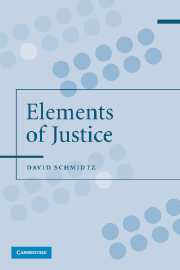Book contents
- Frontmatter
- Contents
- Acknowledgments
- PART 1 WHAT IS JUSTICE?
- 1 The Neighborhood of Justice
- 2 The Basic Concept
- 3 A Variety of Contestants
- 4 Contextual Functionalism
- 5 What Is Theory?
- PART 2 HOW TO DESERVE
- PART 3 HOW TO RECIPROCATE
- PART 4 EQUAL RESPECT AND EQUAL SHARES
- PART 5 MEDITATIONS ON NEED
- PART 6 THE RIGHT TO DISTRIBUTE
- References
- Index
1 - The Neighborhood of Justice
Published online by Cambridge University Press: 05 June 2012
- Frontmatter
- Contents
- Acknowledgments
- PART 1 WHAT IS JUSTICE?
- 1 The Neighborhood of Justice
- 2 The Basic Concept
- 3 A Variety of Contestants
- 4 Contextual Functionalism
- 5 What Is Theory?
- PART 2 HOW TO DESERVE
- PART 3 HOW TO RECIPROCATE
- PART 4 EQUAL RESPECT AND EQUAL SHARES
- PART 5 MEDITATIONS ON NEED
- PART 6 THE RIGHT TO DISTRIBUTE
- References
- Index
Summary
Thesis: Theorists disagree. It is not their fault. Theorizing does not lead to consensus.
PRELIMINARY SURVEY
When I survey the terrain of justice, here is what I see. What we call justice is a constellation of somewhat related elements. I see a degree of integration and unity, but the integrity of justice is limited, more like the integrity of a neighborhood than of a building. A good neighborhood is functional, a place where people can live well. Yet, good neighborhoods are not designed in the comprehensive way that good buildings are. (Indeed, designed communities feel fake, like movie sets, with histories too obviously tracing back to the dated plan of a single mind.)
Is there a defining property of the neighborhood of justice, in virtue of which the word applies? Yes, Part 1 explains, but the property is general and formal; how it translates into more substantive principles depends on context. Parts 2 through 5 reflect on four substantive elements: desert, reciprocity, equality, and need. Part 6 pays homage to John Rawls and Robert Nozick, who “arguably framed the landscape of academic political philosophy in the last decades of the twentieth century.” My theorizing is inspired by (although perhaps only vaguely resembles) theirs.
- Type
- Chapter
- Information
- The Elements of Justice , pp. 3 - 6Publisher: Cambridge University PressPrint publication year: 2006

